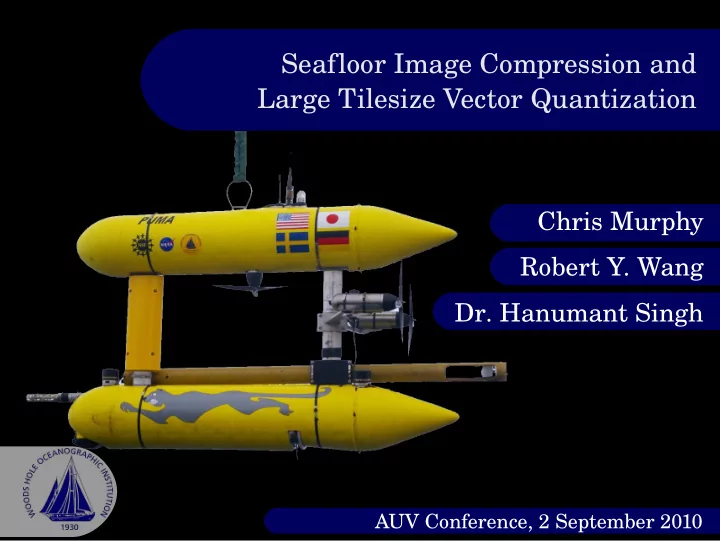

Seafloor Image Compression and Large Tilesize Vector Quantization Chris Murphy Robert Y. Wang Dr. Hanumant Singh AUV Conference, 2 September 2010
Environmental Sensors 2 AUV Conference, 2 September 2010
Sidescan Sonar Imagery 3 AUV Conference, 2 September 2010
Photographs 4 AUV Conference, 2 September 2010
The Problem Data is typically unavailable until after recovery. Effective collaboration requires information sharing, whether from sub-sea to surface or sub-sea to sub-sea. In real-world conditions, effective throughput of modern acoustic modems can be 10-100 bits per second. How can we effectively share multimodal information at these rates? 5 AUV Conference, 2 September 2010
Two Complimentary Approaches Large Tilesize Vector Quantization SPIHT 6 AUV Conference, 2 September 2010
Concept: LTVQ Frequently, we have imagery available from previous dives that is similar in content; possibly from the same geographic location. How can these previous photos be used to Improve image compression? 7 AUV Conference, 2 September 2010
Vector Quantization Basic Idea: 1 • Encode samples by referencing indices of previously established 2 “codewords”. The appropriate 3 codeword is selected as the “closest” using some metric, such as L2 1, 2 (Euclidean) distance. • 4 4, 1.8 1.2, 2.1 5 8 AUV Conference, 2 September 2010
Vector Quantization Basic Idea: • Encode a large number of samples simply by referencing the index of a 1 previously established “codeword” which is closest using some metric, 2 such as L2 distance. 3 • • Early image compression algorithms used this technique to encode small 1,2 (eg: 4x4) squares of pixels. 4 4, 1.8 5 • 9 AUV Conference, 2 September 2010
Compressed Image Size Compressing 4x4 blocks of pixels can only go so far. How can we use VQ to obtain very high compression ratios? 10 AUV Conference, 2 September 2010
Inspiration 11 AUV Conference, 2 September 2010
Compressed Image Size So – how can we use VQ to obtain very high compression ratios? Simple - increase the size of the tiles! 12 AUV Conference, 2 September 2010
Large Tilesize Vector Quantization Even relatively large seafloor image tiles (here, 24 pixels square) exhibit homogeneity. Previous dive imagery can be sliced into tiles to obtain codewords for future dives. 13 AUV Conference, 2 September 2010
Example All tiles taken from 150 randomly selected images, collected on a previous dive. 14 AUV Conference, 2 September 2010
15 AUV Conference, 2 September 2010
Codeword Matching Problem: The number of possible codewords (or “tiles”) generated from even a single dive can be huge. Pixel-by-pixel comparison against each of them is computationally impractical, especially for an AUV. 24 x 24 x 3 = 1728 comparisons per tile. 16 AUV Conference, 2 September 2010
Codeword Matching Solution: Calculate principle components for the tiles using PCA. Match principle component weights to reduce dimensionality, rather than tiles directly. 17 AUV Conference, 2 September 2010
De-Blocking Reconstructed images exhibit heavy blocking artifacts at tile boundaries. How can those artifacts be reduced or eliminated? 18 AUV Conference, 2 September 2010
“Image Quilting” / MinCuts Minimize error at tile borders by carefully selecting tile boundary. Efros + Freeman, “Image Quilting for Texture Synthesis and Transfer,” SIGGRAPH 2001. 19 AUV Conference, 2 September 2010
Poisson Image Editing Interpolate within boundaries, while preserving gradients. Perez et al., “Poisson image editing,” ACM Trans. Graph., 2003. 20 AUV Conference, 2 September 2010
21 AUV Conference, 2 September 2010
22 AUV Conference, 2 September 2010
SPIHT Set Partitioning In Hierarchical Trees * Works in Wavelet Domain ● Wavelets have been shown to provide an efficient, sparse representation for a variety of real-world signals. Dimensionality-Independent ● Same encoding works for CTD data, Imagery, Volumetric data Embedded Coding ● Low-fidelity versions are identical to the beginning of high-fidelity ● Each additional (in-order) byte improves the estimate ● Sending up a higher quality version doesn't require 'starting over' * Said and Pearlman, 1996 23 AUV Conference, 2 September 2010
Fully Embedded Coding Fully embedded coding – A high quality version of encoded data shares first N bits identically with a poor quality encoding of length N. Low Quality Preview Medium Quality Representation High Quality Representation If preview is interesting, recipients can request additional packets to obtain high quality sections of signals or images. 24 AUV Conference, 2 September 2010
Reduction Potential - 28 Bytes 25 AUV Conference, 2 September 2010
Reduction Potential - 56 Bytes 26 AUV Conference, 2 September 2010
Reduction Potential - 112 Bytes 27 AUV Conference, 2 September 2010
Temperature - 28 Bytes 28 AUV Conference, 2 September 2010
Temperature - 56 Bytes 29 AUV Conference, 2 September 2010
Temperature - 112 Bytes 30 AUV Conference, 2 September 2010
Sidescan Imagery 1008 Bytes 4032 Bytes 31 AUV Conference, 2 September 2010
Sidescan Imagery 1008 Bytes 4032 Bytes 32 AUV Conference, 2 September 2010
Sidescan Imagery 315 Bytes 1008 Bytes 33 AUV Conference, 2 September 2010
Live Trials near Rota North of Guam, 1600mi east of the Philippines 34 AUV Conference, 2 September 2010
Original 35 AUV Conference, 2 September 2010
4032 Bytes 36 AUV Conference, 2 September 2010
37 AUV Conference, 2 September 2010
38 AUV Conference, 2 September 2010
1008 Bytes 2016 Bytes 3024 Bytes 4032 Bytes 5040 Bytes 6048 Bytes 7056 Bytes 8064 Bytes 39 AUV Conference, 2 September 2010 9072 Bytes 10080 Bytes 11088 Bytes 12096 Bytes
A Side Note About Compression It is easier to compress more (correlated) data than less. Thus, the less often you share information the more efficiently you can share it. How does this affect our communication strategy? 40 AUV Conference, 2 September 2010
Thank You. chrismurf @ whoi.edu 41 AUV Conference, 2 September 2010
Brief Introduction to SPIHT Sorting Bits Indicate ● Is a coefficient “significant”? ● Are any descendants? ● Any grand-descendant? Refinement Bits Indicate ● The sign of a coefficient ● Coefficient magnitude 42 AUV Conference, 2 September 2010
Recommend
More recommend